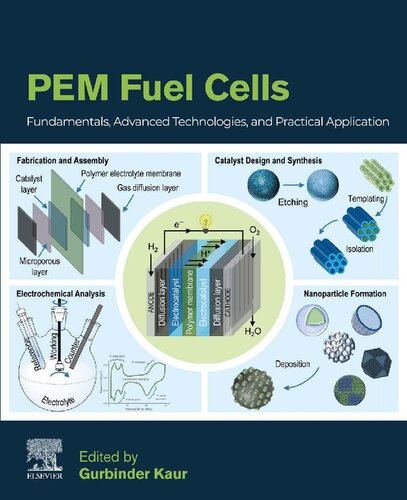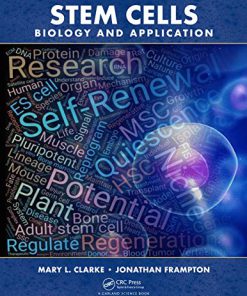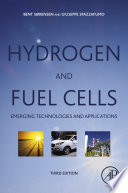PEM Fuel Cells Fundamentals Advanced Technologies and Practical Application 1st Edition by Gurbinder Kaur 0128237090 9780128237090
$50.00 Original price was: $50.00.$25.00Current price is: $25.00.
PEM Fuel Cells Fundamentals Advanced Technologies and Practical Application 1st Edition by Gurbinder Kaur – Ebook PDF Instant Download/Delivery: 0128237090, 9780128237090
Full download PEM Fuel Cells Fundamentals Advanced Technologies and Practical Application 1st Edition after payment
Product details:
ISBN 10: 0128237090
ISBN 13: 9780128237090
Author: Gurbinder Kaur
The opening chapters address the basics of PEM technology; stacking and membrane electrode assembly for PEM, degradation mechanisms of electrocatalysts, platinum dissolution and redeposition, carbon-support corrosion, bipolar plates and carbon nanotubes for the PEM, and gas diffusion layers. Thermodynamics, operating conditions, and electrochemistry address fuel cell efficiency and the fundamental workings of the PEM. Instruments and techniques for testing and diagnosis are then presented alongside practical tests. Dedicated chapters explain how to use MATLAB and COMSOL to conduct simulation and modeling of catalysts, gas diffusion layers, assembly, and membrane. Degradation and failure modes are discussed in detail, providing strategies and protocols for mitigation. High-temperature PEMs are also examined, as are the fundamentals of EIS. Critically, the environmental impact and life cycle of the production and storage of hydrogen are addressed, as are the risk and durability issues of PEMFC technology. Dedicated chapters are presented on the economics and commercialization of PEMFCs, including discussion of installation costs, initial capital costs, and the regulatory frameworks; apart from this, there is a separate chapter on their application to the automotive industry. Finally, future challenges and applications are considered.
PEM Fuel Cells: Fundamentals, Advanced Technologies, and Practical Application provides an in-depth and comprehensive reference on every aspect of PEM fuel cells fundamentals, ideal for researchers, graduates, and students.
- Presents the fundamentals of PEM fuel cell technology, electrolytes, membranes, modeling, conductivity, recent trends, and future applications
- Addresses commercialization, public policy, and the environmental impacts of PEMFC in dedicated chapters
- Presents state-of-the-art PEMFC research alongside the underlying concepts
PEM Fuel Cells Fundamentals Advanced Technologies and Practical Application 1st Table of contents:
Chapter 1. Proton exchange membrane fuel cells: fundamentals, advanced technologies, and practical applications
Abstract
1.1 Introduction
1.2 Proton exchange membrane fuel cells
1.3 Components of PEM fuel cells
1.4 Practical applications of PEM fuel cells
1.5 Summary
References
Chapter 2. Proton exchange membrane for microbial fuel cells
Abstract
2.1 Biofuel cells
2.2 Microbial fuel cell
2.3 Types of ion exchange membrane in microbial fuel cell
2.4 Essential cation exchange membrane properties and its determination
2.5 Polymeric membranes
2.6 Salt bridge
2.7 Ceramic membranes
2.8 Membrane-less microbial fuel cell
2.9 Conclusion
References
Chapter 3. Electrocatalysts: selectivity and utilization
Abstract
3.1 Introduction
3.2 Optimization parameters
3.3 Summary
References
Chapter 4. Bipolar plates for the permeable exchange membrane: carbon nanotubes as an alternative
Abstract
4.1 Introduction
4.2 Polymer electrolyte membrane fuel cells
4.3 Carbon nanotubes
4.4 Researches on permeable exchange membrane fuel cells and carbon nanotubes
4.5 Discussion
4.6 Other applications
4.7 Conclusion
Acknowledgments
References
Chapter 5. Gas diffusion layer for proton exchange membrane fuel cells
Abstract
5.1 Introduction
5.2 Gas diffusion layer materials
5.3 Gas diffusion layer properties
5.4 Modifications of gas diffusion layers
5.5 Durability of gas diffusion layer
5.6 Summary
References
Chapter 6. Thermodynamics and operating conditions for proton exchange membrane fuel cells
Abstract
6.1 Introduction
6.2 Hydrogen higher and lower heating value
6.3 Thermodynamics of fuel cells
6.4 First law analysis
6.5 Second law analysis
6.6 Effect of cell conditions of reversible voltage
6.7 Efficiency of fuel cells
6.8 Chapter summary
References
Chapter 7. Proton exchange membrane testing and diagnostics
Abstract
7.1 General overview
7.2 Testing of proton exchange membrane fuel cell
7.3 Diagnostic tools for proton exchange membrane fuel cell
7.4 Summary
References
Chapter 8. Charge and mass transport and modeling principles in proton-exchange membrane (PEM) fuel cells
Abstract
8.1 Introduction
8.2 PEM thermodynamics and electrochemistry
8.3 Charge and mass transport in membrane-electrode-assembly
8.4 Modeling mass transport in a fuel cell
8.5 Closing remarks
References
Chapter 9. Degradation and failure modes in proton exchange membrane fuel cells
Abstract
9.1 Introduction
9.2 Failure modes and degradation
9.3 Stressors in proton exchange membrane fuel cells
References
Chapter 10. High-temperature proton exchange membrane—an insight
Abstract
10.1 Introduction
10.2 HT-PEMFC materials
10.3 HT-PEMFC stacks and systems
10.4 Durability in HT-PEMFC
10.5 Degradation mechanisms: materials
10.6 Applications of HT-PEMFC
10.7 Conclusion
Acknowledgments
References
Chapter 11. Advanced modifications in nonnoble materials for proton exchange membrane
Abstract
11.1 Introduction
11.2 Role of noble meatal (Pt) catalyst
11.3 Alternatives to pure platinum
11.4 Features of nonnoble materials for proton exchange membrane fuel cells
11.5 Nonnoble materials for proton exchange membrane fuel cells
11.6 Conclusion
11.7 Future perspective
References
Chapter 12. Technological risks and durability issues for the Proton Exchange Membrane Fuel Cell technology
Abstract
12.1 Introduction
12.2 Working of proton exchange membrane fuel cells
12.3 Major challenges in proton exchange membrane fuel cells
12.4 Sluggish oxygen reduction reaction kinetics
12.5 Effect of electrocatalysts and carbon support materials
12.6 Durability issues and deterioration mechanism
12.7 Conclusions
Acknowledgments
References
Further reading
Chapter 13. Porous media flow field for proton exchange membrane fuel cells
Abstract
13.1 Introduction
13.2 Structure of porous media flow field
13.3 Material property of porous media flow field
13.4 Porous media flow field performance
13.5 Summary
References
Chapter 14. Automotive applications of PEM technology
Abstract
14.1 Fuel cells (FCs) in transportation applications
14.2 FC drive train configuration
14.3 FC market
14.4 Well to wheel greenhouse gas emission of cars
14.5 FC manufacturing cost
14.6 Total life cycle cost of the vehicle
14.7 Latest progress in PEM automotive applications
14.8 Latest industrial progress in FCVs
References
Chapter 15. Economic, business, technical, and commercialization hindrances for the polymer electrolyte membrane fuel cell
Abstract
15.1 Overview of PEMFC technology
15.2 Challenges in PEMFC technology
15.3 Technical challenges
15.4 Conclusions
References
Chapter 16. Configuration of proton exchange membrane fuel cell gas and cooling flow fields
Abstract
16.1 Introduction
16.2 Bipolar plates
16.3 Flow channels and cooling channels
16.4 Shape and size of gas flow channels and cooling channels
16.5 Flow field orientation
16.6 Configurations of gas and cooling channels
References
Chapter 17. Nanocatalysts for proton exchange fuel cells: design, preparation, and utilization
Abstract
17.1 Introduction
17.2 Fundamentals of the oxygen reduction reaction mechanism
17.3 The science behind pure metal catalysts
17.4 Design parameters for optimizing catalyst composition
17.5 Design parameters for optimizing catalyst structure
17.6 Overview of synthetic and fabrication methods used to prepare membrane electrode assemblies
17.7 Conclusion
Acknowledgments
References
Index
People also search for PEM Fuel Cells Fundamentals Advanced Technologies and Practical Application 1st :
pem fuel cells theory and practice
pem fuel cell testing and diagnosis
pem fuel cells
fuel cells fundamentals
Tags:
Gurbinder Kaur,Fuel Cells Fundamentals,Advanced Technologies
You may also like…
Uncategorized
Education Studies & Teaching - Studying & Test Preparation
Uncategorized
Technique - Energy: Renewable Energy
Hydrogen and Fuel Cells Emerging Technologies and Applications 3rd Edition Bent Sørensen
Engineering - Energy & Power Resources
Engineering - Chemical Engineering
Progress and Recent Trends in Microbial Fuel Cells 1st Edition Patit Paban Kundu
Biology and other natural sciences - Biotechnology
Engineering - Energy & Power Resources
Introduction to Transfer Phenomena in PEM Fuel Cells 1st Edition Bilal Abderezzak












